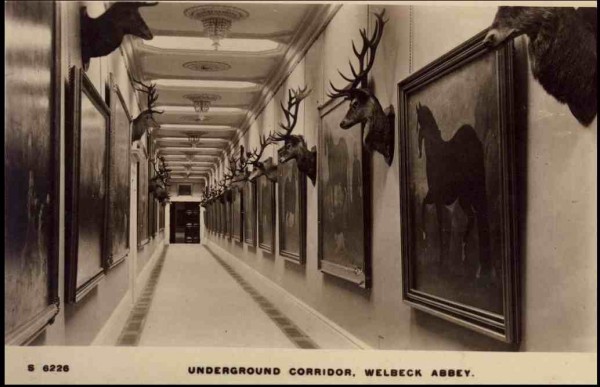Welbeck Abbey

A famous eccentric, the Fifth Duke of Portland spent a fortune over twenty-five years constructing fantastical additions to his estate, Welbeck Abbey, including fifteen miles of underground tunnels.
The Duke was very introverted - he did not want to meet people and never invited anyone to his home. His rooms had double letterboxes, one for ingoing and another for outgoing mail. His valet was the only person he permitted to see him in person in his quarters - he would not even let the doctor in, while his tenants and workmen were told never to acknowledge his presence (a workman who saluted him was reputedly dismissed on the spot) and they received all their instructions in writing.
His business with his solicitors, agents, and the occasional politician was handled by post. The Duke maintained an extensive correspondence with a wide-ranging network of family and friends, including Benjamin Disraeli and Lord Palmerston. He is not known to have kept company with any ladies, and his shyness and introverted personality increased over time.
His reclusive lifestyle led to rumours that the Duke was disfigured, mad, or prone to wild orgies, but contemporary witnesses and surviving photographs present him as a normal-looking man.
He ventured outside mainly by night, when he was preceded by a lady servant carrying a lantern 40 yards ahead of him. If he did walk out by day, the Duke wore two overcoats, an extremely tall hat, an extremely high collar, and carried a very large umbrella behind which he tried to hide if someone addressed him.
If the Duke had business in London, he would take his carriage to Worksop where he had it loaded onto a railway wagon. Upon his arrival at his London residence, Harcourt House in Cavendish Square, all the household staff were ordered to keep out of sight as he hurried into his study through the front hall.
He insisted on a chicken roasting at all hours of the day, and the servants brought him his food on heated trucks that ran on rails through the underground tunnels.
Wikipedia page.
Long essay here.
Comments
The true story is that the 'duke' was really a female that the previous duke (her father) had never acknowledged as such (even going so far as to claim the babe was male) and, having been treated as a male her whole life took on that role. Had her true sex been discovered she would have been dispossessed of all her holdings and/or forced into marriage.
True story, honest.
True story, honest.
Posted by Expat47 in Athens, Greece on 01/27/15 at 10:08 AM
Wow Expat, you should update the Wiki page with that!
Posted by Patty in Ohio, USA on 01/27/15 at 12:03 PM
They rejected my offering even though I refused to site any proof.
Posted by Expat47 in Athens, Greece on 01/27/15 at 12:28 PM
Sounds like the English version of Billy Tipton.
The Old World is full of stuff like this. There are two former chateaux in Cognac, France that are linked by a tunnel under the river.
The Old World is full of stuff like this. There are two former chateaux in Cognac, France that are linked by a tunnel under the river.
Posted by KDP on 01/27/15 at 02:41 PM
Yet another sign that all titles of nobility, and the rights, and wealth, and privileges, that come with it are just another control mechanism to keep POWER and MONEY in the hands of those they can control.
Posted by atrax72 on 01/28/15 at 03:52 AM
Some people are just shy.
Posted by IntrovertExtrovert on 01/28/15 at 11:23 AM
Eccentric, weird English lords and ladies.
Posted by Gator Guy on 01/28/15 at 06:20 PM
Commenting is not available in this channel entry.

Category: Architecture | Eccentrics | Europe | Nineteenth Century